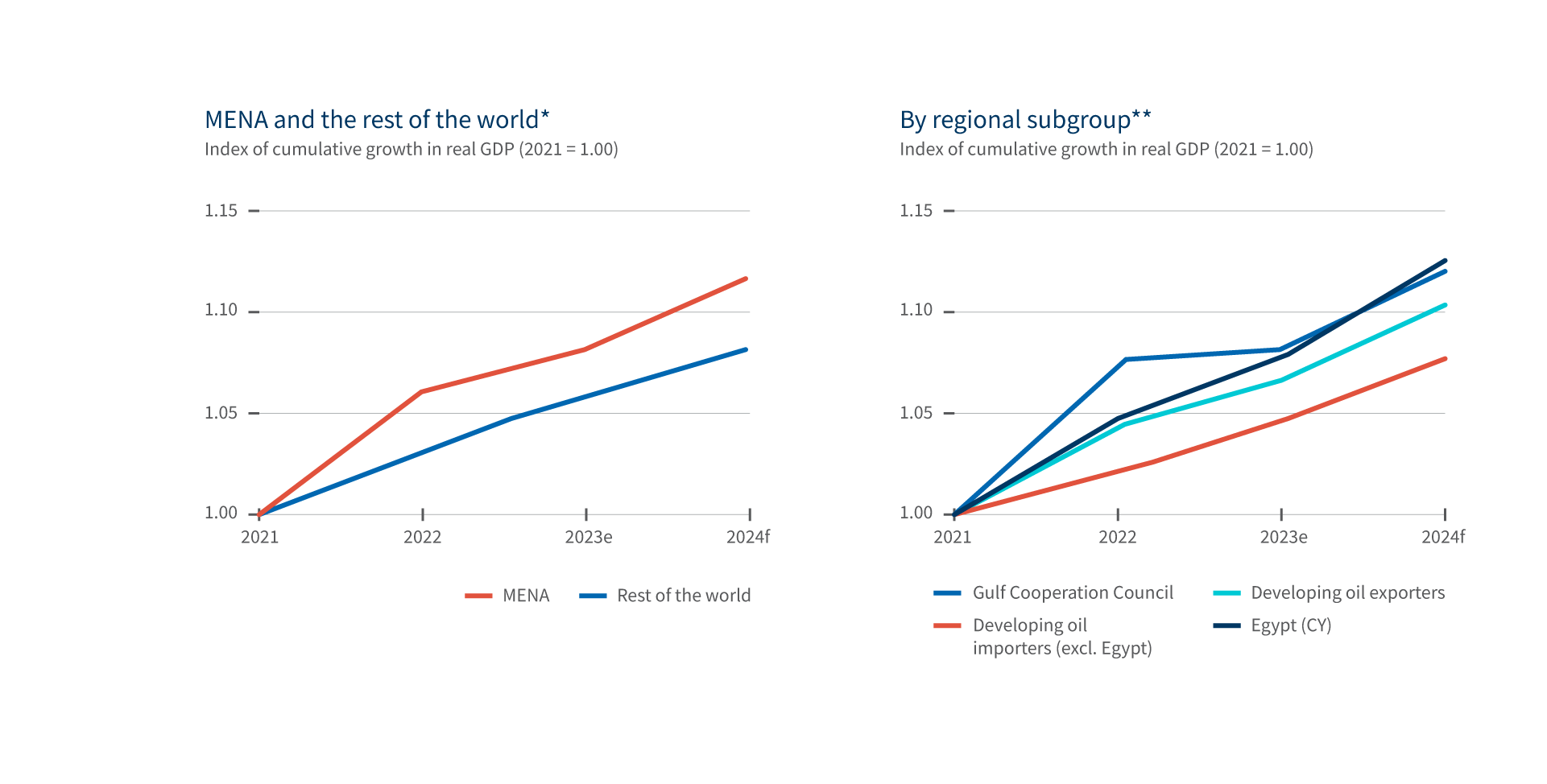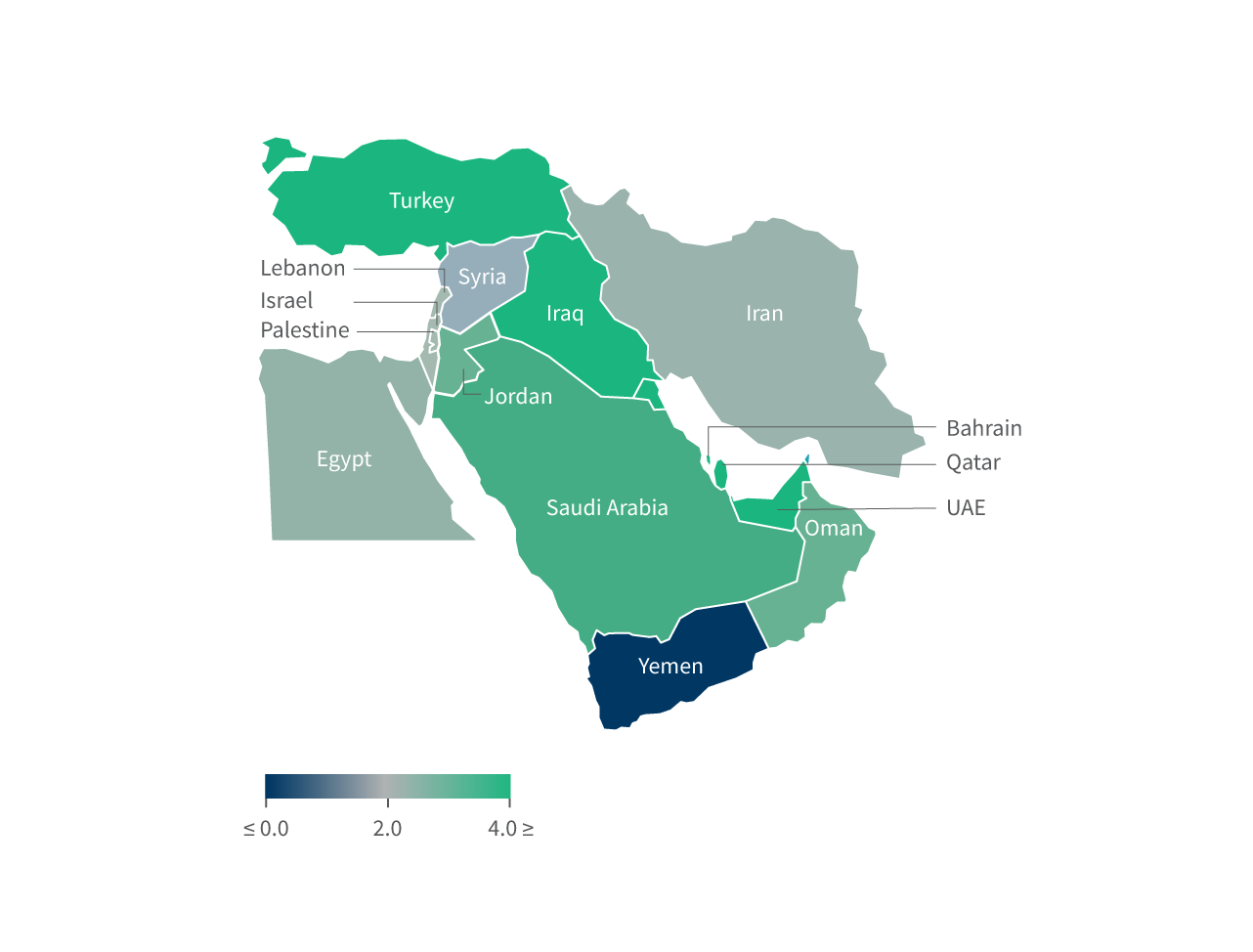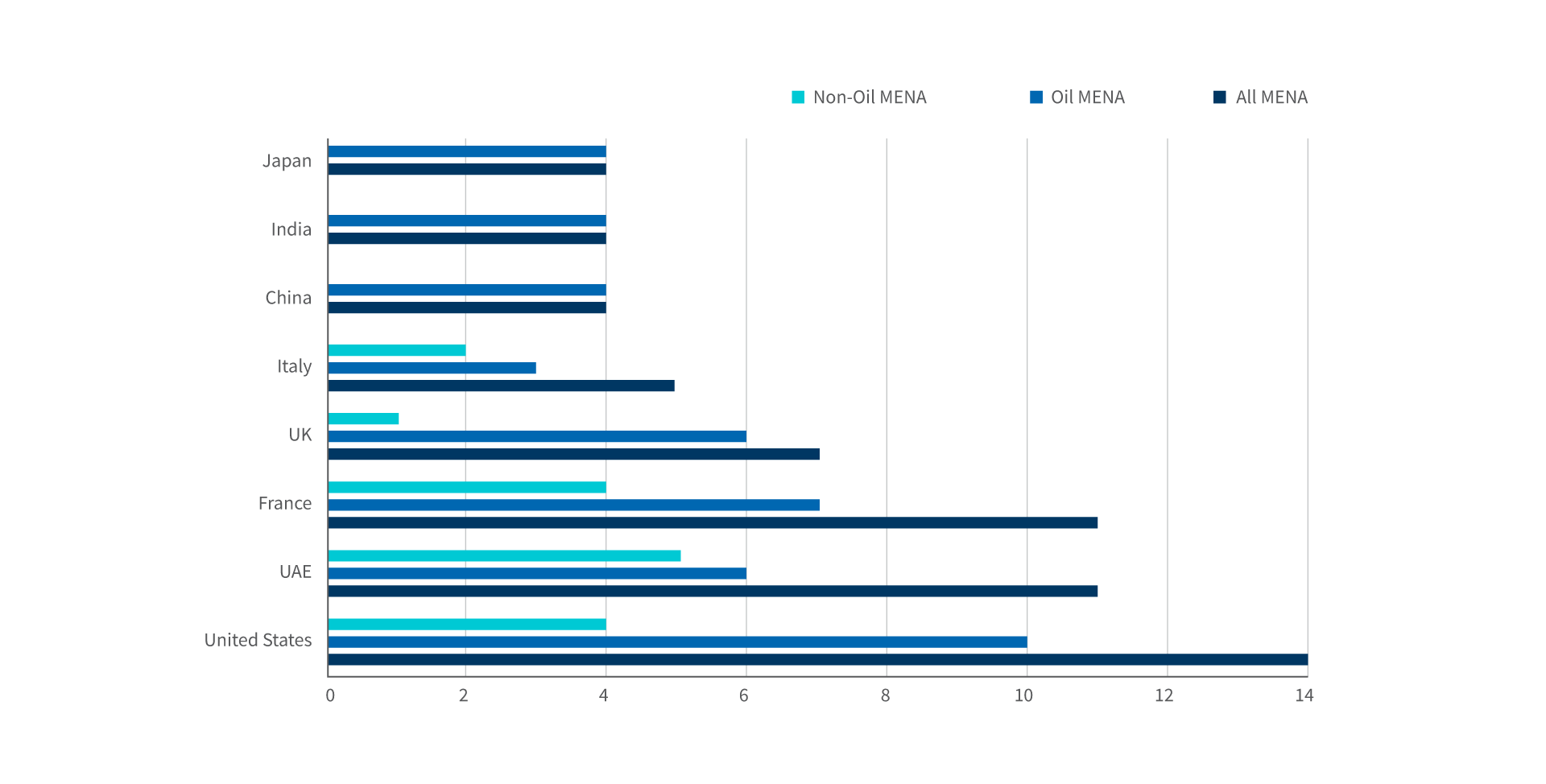- Home
- / Insights
- / FTI Journal
- / Getting in on the Ground Floor in the ‘Land of the Future’
Getting In on the Ground Floor in the ‘Land of the Future’

-
November 20, 2023
-
In the far northwest corner of the Kingdom of Saudi Arabia, a futuristic megacity is rising out of the desert.
Known as NEOM, the massive $500 billion project, financed by the Kingdom itself, is intended to diversify the energy-dependent economy by creating unprecedented outside investment opportunities to create joint ventures, local operations and new business entities there.1 The Saudi government’s overview of NEOM — dubbed the “land of the future” by project planners — named these prime sectors: health, well-being and biotech; technology and digital; entertainment and culture; media; financial services; design and construction; and education, research and innovation.2,3
At the World Economic Summit in Davos last January, the CEO of NEOM declared that 20 percent of the project’s infrastructure was complete.4 But even as NEOM gets the lion’s share of publicity, it is just one of many ongoing large-scale investment opportunities across the Middle East and North Africa (“MENA”) region. The governments in Riyadh and Abu Dhabi, for instance, are financing their own multibillion-dollar projects designed to diversify their economies.5 Taken as a whole, year-over-year GDP growth in MENA is expected to rise by more than 50 percent, from 1.9 percent in 2023 to 3.2 percent in 2024.6
Index of Actual and Projected Cumulative GDP Growth in MENA, 2021-24
*MENA includes Algeria, Bahrain, Djibouti, Egypt, the Islamic Republic of Iran, Iraq, Jordan, Kuwait, Morocco, Oman, Qatar, Saudi Arabia, Tunisia, the United Arab Emirates, and the West Bank and Gaza. The Gulf Cooperation Council includes Bahrain, Kuwait, Oman, Qatar, Saudi Arabia, and the United Arab Emirates. Developing oil exporters include Algeria, the Islamic Republic of Iran, and Iraq. Developing oil importers excluding Egypt include Djibouti, Jordan, Morocco, Tunisia, and the West Bank and Gaza. Real GDP estimates for Egypt in panel b correspond to calendar years.
**Regional and subregional weighted-average real GDP growth rates were calculated using previous year real GDP levels as weights.
Graphs recreated from original source: World Bank Group7
Given these circumstances, it’s not surprising that investors are taking a close look at where they might stake their funds. Understanding how best to concentrate those efforts can help identify high-growth opportunities while minimizing the challenges of entering such a distinct market.
Maximizing Opportunities
Among the many options to consider in MENA, the entertainment, media and egaming industry jumps out as perhaps the biggest white space for investors. That’s true for two reasons: 1) The region is flush with a growing youth population ready to exercise their spending power;8 and 2) government decision-makers, in a bid to attract more foreign investment and tourism, have been implementing social reforms in areas such as live entertainment, sporting events and alcohol consumption.9,10,11
According to the trade publication Esports Insider, 15 percent of egamers today live in MENA, where revenue by egaming firms operating there is expected to rise by more than 20 percent between 2019 and 2024.12 The Saudi government itself has publicly pledged to spend up to $40 billion between 2022 and 2030 to develop its domestic esports industry.13 The stated goal is to compete for a share of the fast-growing $320 billion global egaming industry, according to media reports.14
Media and entertainment are also booming, especially so in the Middle Eastern countries.15 A Morder Intelligence report forecasts that the sector will grow from $39 billion in 2023 to $61 billion in 2028. That expansion is driven by “cultural shifts among the region's young people” and “untapped demand for local Arabic content.”16 According to Morder Intelligence, “The media and entertainment industry has been one of the first business sectors to steer digital disruption, and its transformation is far from over.”17
Middle East: Economic Growth, 2023
(real GDP; % change, year on year)
Graph recreated from original source: Economist Intelligence Unit18
The U.S. State Department also has identified Saudi Arabia’s fast-growing media, entertainment and sports industries as “primed for foreign investment.”19 In a report entitled “2023 Investment Climate Statements: Saudi Arabia,” the agency states that the Kingdom “aims to become a major transport and logistics hub linking Asia, Europe and Africa. Infrastructure projects related to this goal include various ‘economic cities’ and special economic zones, which will serve as hubs for petrochemicals, mining, logistics, manufacturing and digital industries.”20
In a similar vein, the United Arab Emirates intends to grow its media, entertainment and esports sectors in part by changing its immigration laws to attract more foreign workers.21 In 2021, the Abu Dhabi Department of Culture and Tourism launched a new visa category specifically for individuals “working in cultural and creative industries,” including esports, media and publishing.22
Minimizing Challenges
Investors know that breaking into any new market has its challenges. In the case of MENA, joint ventures and other partnerships with entertainment, media and esports firms that already have a foothold in the region offer the best glide path to entry. These established relationships may also help navigate the complex process of obtaining financial incentives from the Saudi government, which is pressing ahead with an ambitious plan (“Vision 2030”) to attract direct foreign investment.23
There are caveats. The U.S. State Department says that “investor concerns persist regarding business predictability, transparency and political risk.”24 Given the scope and extended project time frame, identifying the resources needed to conduct large-scale project modeling, research and planning also pose a considerable hurdle to all but the largest global firms.25
Top Investors in MENA
(Number of times a given country is among the top five in any MENA country)
Graphic recreated from original source: The Islamic Corporation for the Insurance of Investment and Export Credit26
Any proposal therefore must be comprehensive, sustainable and innovative, as well as agile and scalable. Investors should first identify all possible risks involved in such an investment, followed by developing a corporate strategy that will direct their approach. Then, they should develop a business plan and financial projections, operating model and detailed go-to-market methodologies. Finally, interested investors should also develop an ESG strategy and communications plan, as specific, long-standing regional challenges such as government transparency, corruption and political accountability persist.27
State Department officials also caution that generous subsidies for foreign investors and a relaxation of certain domestic restrictions may not go on indefinitely.28 They add that the window may soon shut altogether for multinational corporations that do not already have a presence there.29
“The pressure to generate non-oil revenue [streams] and provide increased employment opportunities for Saudi citizens has prompted the [Saudi Arabian government] to implement measures that may weaken the country’s investment climate going forward,” agency officials wrote.30 “Additionally, Saudi Arabia announced in 2021 that multinational companies wanting to contract with the [Saudi government] must establish their regional headquarters in [the Kingdom] by 2024.”31
The growing media, entertainment and esports industries in Saudi Arabia and throughout MENA represent intriguing opportunities for investors. That said, understanding how to address concerns and navigate the unique factors associated with a winning MENA investment strategy requires expertise in areas such as law, communications, finance, trade and taxation.
Footnotes:
1: “Saudis Set $500 Billion Plan to Develop Zone Linked with Jordan and Egypt,” CNBC (October 24, 2017).
2: “What is Neom,” Neom.com (accessed November 2, 2023).
3: “Sectors,” Neom.com (accessed November 2, 2023).
4: Bugos, Matthew,“ One-fifth of NEOM, Saud Arabia’s, Futuristic Gigacity, is Already Complete According to CEO.” Designboom, (February 22, 2023).
5: Dudley, Dominic, “Saudi Arabia And Abu Dhabi Launch Ambitious Drives To Diversify Economies.” Forbes, (June 30, 2022).
6: “GCC Will Drive MENA Growth In 2024.” Fitch Solutions, (September 15, 2023).
7: Gatti, Roberta, and Daniel Lederman, et al., “Balancing Act: Jobs and Wages in the Middle East and North America When Crises Hit,” Media Economic Update: October 2023, p. 6, World Bank Group (accessed November 2, 2023).
8: Mati, Amine and Sidra Rehman, “Saudi Arabia to Grow at Fastest Pace in a Decade.” International Monetary Fund, (August 17, 2022).
9: Chablani, Nitya, “For the First Time in History, a Resort in Saudi Arabia Will Reportedly Serve Alcoholic Beverages.” Vogue, (September 19, 2022).
10: Pietsch, Bryan, “Dubai puts alcohol tax on ice as it competes for tourists, expats.” The Washington Post, (January. 3, 2023).
11: “New national training program in Saudi Arabia seeks to support booming tourism sector.” Alarabiya News, (June 8, 2022).
12: Almadani, Hisham, “DMCC predicts massive revenue growth for MENA gaming by 2027.” Esports Insider, (May 31, 2023).
13: “Saudi Arabia heading to the next level thanks to esports gamble.” Arab News, (July 29, 2023).
14: Id.
15: “Middle East Media and Entertainment Market Size & Share Analysis - Growth Trends & Forecasts (2023 - 2028),” Morder Intelligence (accessed October 20, 2023).
16: Id.
17: Id.
18: “Eiu Report: Middle East Outlook 2023,” Economist Intelligence Unit (accessed November 2, 2023).
19: “2023 Investment Climate Statements: Saudi Arabia” U.S. State Dept (accessed September 21, 2023), .
20: Id.
21: “2023 Investment Climate Statements: United Arab Emirates,” U.S. State Dept (Accessed September 21, 2023).
22: Id.
23: “Saudi Cabinet Approves Incentives for Localization of Priority Goods, Services,” Arab News (February 22, 2023), .
24: “2023 Investment Climate Statements: Saudi Arabia” U.S. State Dept (accessed September 21, 2023), .
25: Id.
26: “Supporting Economic Growth: Foreign Direct Investment in the MENA Region,” ICIEC.isdb.org (2023; accessed November 2, 2023).
27: Abed, George T. and Hamid Davoodi, “Challenges of Growth and Globalization in the Middle East and North Africa,” International Monetary Fund (accessed October 11, 2023).
28: “2023 Investment Climate Statements: Saudi Arabia” U.S. State Dept (accessed September 21, 2023).
29: Id.
30: Id.
31: Id.
© Copyright 2023. The views expressed herein are those of the author(s) and not necessarily the views of FTI Consulting, Inc., its management, its subsidiaries, its affiliates, or its other professionals.
About The Journal
The FTI Journal publication offers deep and engaging insights to contextualize the issues that matter, and explores topics that will impact the risks your business faces and its reputation.





